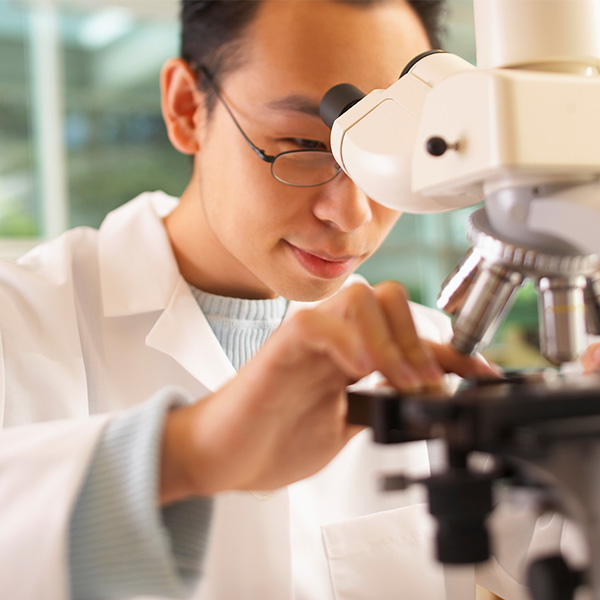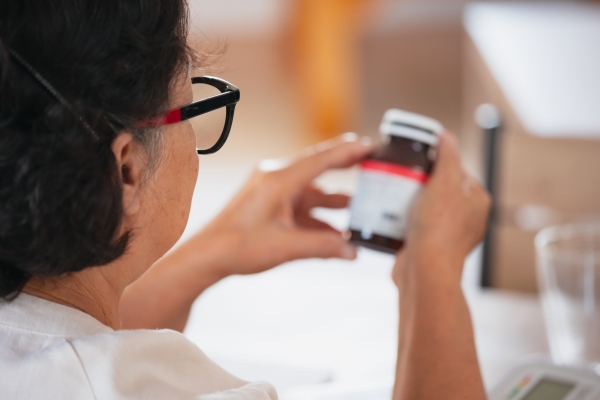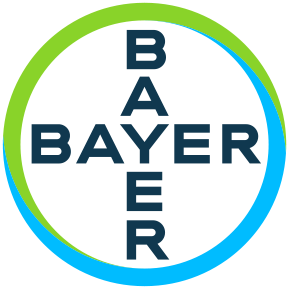Where Do New Medicines Come From?

Scientist looking through a microscope (Bayer. Used with permission.)

Scientist looking through a microscope (Bayer. Used with permission.)
How does this align with my curriculum?
| Grade | Course | Topic |
|---|
Learn how new medicines are developed and tested in Canada.
Did you know it can take thousands of people many years to develop a new medicine? Maybe you’ve never thought about it. But the medicines in your bathroom cabinet have been carefully tested. Teams of scientists, doctors, nurses and research participants work together to make sure they’re safe and that they work properly. Part of this process is called clinical trials.
Let’s Talk Science spoke to Jane McBride and Shurjeel Choudhri from the pharmaceutical, crop science and health company Bayer Inc., about clinical trials and the work they do.
How does it start?
Scientists and pharmaceutical companies research what medicines people need. Sometimes this means working on a treatment for a disease that has never had a treatment before. Sometimes it means working on a new version of a medicine that already exists. This new version could be more effective or have fewer side effects. Sometimes this means working with statisticians to predict what people will need in the future. People are living longer all the time. This means they often need medicines to treat the diseases that happen in older age.

Did you know?
Patient-reported outcomes are an important part of developing new medicines. Clinical trial organizers ask patients what would help improve their lives. For example, someone with lung disease might want a medicine that will help them walk further. This is important because it means they can do more of the things they want to do.
How are they tested?
Developing a medicine is different from developing other products. People’s lives and health are at risk. So, scientists follow a rigorous process to test their work. And most new medicines don’t make it through testing.
Shurjeel explains “We start with 3-5 000 molecules, and out of them, usually comes one drug. So, the failure rate is very high.”
The longest part of the testing process is clinical trials. This is when scientists test new medicines on human research participants.
How do we know clinical trials are safe?
Before scientists can start a clinical trial, they must write a study protocol. This document explains how the team plans to complete every step of the trial. The protocol has information about what will be done in the trial and how. It will include details on what kind of patients that can participate in the trial, a schedule of tests, procedures, and the medications for participating patients. Most importantly, it has information about how many research participants are needed and why. It also explains exactly how the team will keep these participants safe.
Did you know?
There are risks and benefits to any medicine. Some medicines can have serious side effects. But as Shurjeel explains, “Sometimes you’re treating a deadly disease. Those side effects are worth risking if you can really manage an otherwise life-threatening condition.”
There are different phases of research in the development of a new medicine. In the phase I clinical trials, a new medicine is only given to a few participants. If scientists see proof that it’s safe, they can move on to the next phase. Most new medicines will go through at least three phases of clinical trials. This means scientists can get enough information to make sure a medicine is safe and works properly. But it also means that scientists do not put research participants at too much risk.
Before a patient can participate in a clinical trial, they must give their informed consent. This process involves doctors or nurses discussing the trial with patients who volunteer to participate. And patients have a chance to ask questions. Then each patient who decides to participate signs an informed consent form. This document explains the purpose of the clinical trial, the treatments used during the trial, and the possible risks and benefits of participating in the trial. It must explain these clearly to people who have no science background. As Jane says, “These materials have to be written in lay language, so anyone could understand them.”

Did you know?
Youth and children have different kinds of informed consent forms. People younger than 16 must assent to participating in a clinical trial. In Canada, children can refuse to participate even if their parents or guardians give consent.
Another important part of the study protocol is the safety monitoring. Scientists are always looking for safety signals. These are also called adverse events. They can be any medical problem, symptom or disease a patient experiences during the trial. It may or may not be caused by or related to the study drug. Doctors must report adverse events. They report them to the trial sponsor and the regulatory body, like Health Canada, that approved the trial.
Who approves clinical trials?
Study protocols aren’t just plans. They’re part of the process to make sure clinical trials are safe. Trial sponsors submit them to outside groups for review and approval. Health Canada must approve study protocols for any phase I-III clinical trial scientists plan to run in Canada. One or more ethics boards must also approve trials before it can begin. Ethics boards are committees in hospitals, at universities, or part of governments. Their job is to make sure all trials involving humans protect the health, dignity and rights of the participants involved.
How are new medicines approved?
A new medicine is only approved after it has completed phase I-III clinical trials. Regulatory bodies will only give approval if they see clear evidence that the benefits of a new medicine outweigh its risks. So, scientists submit the results from all phase I -III clinical trials. This can be a lot of evidence! Shurjeel says, “We’ve had submissions to Health Canada that were over half a million pages… That’s how much work is done to characterize a drug. To demonstrate that it works and that it’s safe.”
What happens after new medicines are approved?
Scientists’ work doesn’t stop when a new medicine is approved. That’s when they start phase IV clinical trials. This is one of the most important phases because it shows scientists how a medicine works in the real world. They want to make sure it does what they thought it would do.
Doctors, scientists, ethics boards and regulatory bodies watch for safety signals in phase I-III clinical trials. As Shurjeel explains, “When we do clinical trials, we want to look at a very controlled population. [This is] so we can identify a true effect of the drug if it’s there. But the real world is messy and it’s got all sorts of different types of patients with different co-morbidities and illnesses. They’re on other medications. There’s no way to test all of that in development.”
Did you know?
A drug label is not just the sticker on the bottle! Sometimes a pharmacist will give you a few pages of information about your medication. But this is just a small part of the official label, which can be 50-70 pages long. These labels are usually updated every year as new information is discovered through phase IV trials. And this continues through the life of the drug. All this information is available online so that doctors, pharmacists and patients can make the best decisions about their health.

Also, scientists can only see some rare side effects of a medicine when it is given to lots of people. “Even the biggest development program may have only 50 or 60 000 patients treated by the drug. So, if you have a side effect that… may occur in 1 in 50 000 patients, you will not identify it during your development protocol. And those are really only identified once the drug is prescribed to millions of people.”
How can clinical trials change during a pandemic?
Most clinical trials take eight to 10 years. Trials for COVID-19 medicines are happening a lot faster than that. But scientists are not rushing through the tests themselves. Every medicine must still complete every required phase of research before it can be approved. Here are some of the reasons for this.
Pharmaceutical companies pay for, or sponsor, most clinical trials. And they make money by selling their medicines.
Companies know they will have a lot of customers for COVID-19 treatments. Because of this, they can spend more money researching and testing them. They can hire more scientists to work on the problem. And they can make sure the teams have all the equipment and supplies they need.
Governments around the world have pre-ordered COVID-19 vaccines and medicines. Usually, companies wait until a medicine is approved before they start spending money on factories and supplies to make large amounts of it. But pre-orders mean companies will spend money getting ready while they are still testing. This is how medicines can be shipped around the world as soon as they’re approved.
Also, people around the world know about the dangers of COVID-19. This means many people and organizations are making treatments a priority. Health Canada is speeding up the process for scientists to apply for approval of trials for COVID treatments. And many members of the public are volunteering as research participants in those trials.

Why are clinical trials important?
Maybe you can already see why clinical trials are important, but Jane and Shurjeel shared some of the reasons they’re passionate about the work they do.
Jane describes a recent project, “I have had the privilege to work on a new medicine that treats patients with a very rare type of cancer. It’s very impactful to hear patient stories and learn how this medicine has had a positive impact on patients’ lives.”
And Shurjeel describes how drug developments have helped his family: “My parents are in their [80s and 90s]. They are both on multiple medications. And the reason why they have lived to this age is because of these treatments that have helped them get there.”

About Bayer
Bayer is a global enterprise with core competencies in the life science fields of health care and nutrition. Its products and services are designed to help people and planet thrive by supporting efforts to master the major challenges presented by a growing and aging global population. Bayer is committed to drive sustainable development and generate a positive impact with its businesses. At the same time, the Group aims to increase its earning power and create value through innovation and growth. The Bayer brand stands for trust, reliability and quality throughout the world. In fiscal 2020, the Group employed around 100,000 people and had sales of 41.4 billion euros. R&D expenses before special items amounted to 4.9 billion euros. For more information, go to www.bayer.ca
Learn More
Why Are Drug Trials Necessary?
This video (1:23 min.) by Bayer briefly explains why we need clinical trials.
Clinical trials and drug safety
This page by Health Canada has information about clinical trials in Canada, and what you should know if you decide to participate.
8 steps to find a cure for a disease
This video (2:02 min.) by Bayer quickly explains how new medicines are developed.
Informed Consent for Research: What to Expect
This video (8:08 min.) by the U.S. Department of Health and Human Services explains how informed consent happens for people interested in volunteering for clinical trials.
Two steps forward, one step back: how World War II changed how we do human research
This article from The Conversation explains how the rules for clinical trials today were created in response to medical experiments during World War II.
ClinicalTrials.gov and Health Canada's Clinical Trials Database
Are you curious about clinical trials happening now? These two websites list trials around the world, and in Canada.
References
British Columbia Public Safety and Emergency Services. (2020 December 14). COVID-19 vaccines.
Canadian Institute for Health Information. (n. d.) Patient-reported outcome measures (PROMs).
Goldhill, O. (2020 June 14). How Covid-19 is changing pharmaceutical research funding. Quartz.
Government of Alberta. Research ethics board. MyHealth.alberta.ca.
Health Canada. (2019 July 10). Requirements for Informed Consent Documents.
Joseph, A. (2020 July 30). How the world made so much progress on a Covid-19 vaccine so fast. STAT.
Kirsh, D. (2019 April 9). The Nuremberg Code and its impact on clinical research. MassDevice.com.
U.S. National Library of Medicine. (2019). Learn About Clinical Studies. ClinicalTrials.gov.